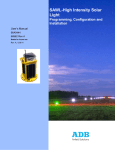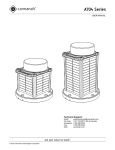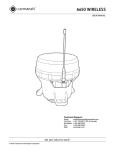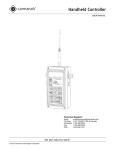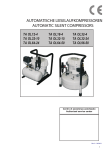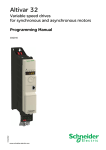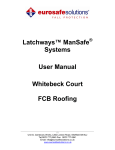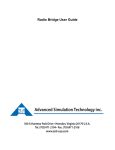Download OL32 User Manual
Transcript
OL10A & OL32 Obstruction Light USER MANUAL Technical Support: Email: Toll Free: Worldwide: Fax: Web: © 2013 Carmanah Technologies Corporation [email protected] 1.877.722.8877 (US & Canada) 1.250.380.0052 1.250.380.0062 carmanah.com OL10A & OL32 OBSTRUCTION LIGHT USER MANUAL Contents 1.0 Safety & Usage ..................................................................................................................................................3 1.1 Viewing Precautions ........................................................................................................................................3 1.2 Battery Precautions .........................................................................................................................................3 1.3 Wireless Precautions .......................................................................................................................................4 1.4 Regulatory .......................................................................................................................................................4 1.5 Warranty Disclaimer ........................................................................................................................................4 2.0 Introduction .......................................................................................................................................................5 2.1 Features ..........................................................................................................................................................5 2.2 Applications .....................................................................................................................................................5 2.3 Design .............................................................................................................................................................6 2.4 Light Intensity ..................................................................................................................................................6 3.0 Installation .........................................................................................................................................................7 3.1 Location ...........................................................................................................................................................8 3.2 Mounting ..........................................................................................................................................................9 4.0 Operation .........................................................................................................................................................10 4.1 Theory of Operation.......................................................................................................................................10 4.2 User Interface ................................................................................................................................................10 4.3 Modes ............................................................................................................................................................13 4.4 Features ........................................................................................................................................................16 5.0 Maintenance ....................................................................................................................................................20 5.1 Inspection ......................................................................................................................................................20 5.2 Storage & Battery Charging ..........................................................................................................................20 5.3 Battery Replacement – OL10A Standard ......................................................................................................21 5.4 Battery Replacement – OL10A High Performance and OL32 ......................................................................24 5.6 Recycling .......................................................................................................................................................28 6.0 Troubleshooting ..............................................................................................................................................29 7.0 Warranty ...........................................................................................................................................................30 8.0 Appendices ......................................................................................................................................................31 8.1 Glossary ........................................................................................................................................................31 8.2 Specifications ................................................................................................................................................32 © 2013 Carmanah Technologies Corporation 2 OL10A & OL32 OBSTRUCTION LIGHT USER MANUAL 1.0 Safety & Usage The following symbols indicate important safety warnings and precautions throughout this manual: WARNING indicates that serious bodily harm or death may result from failure to adhere to the precautions. CAUTION indicates that damage to equipment may result if the instructions are not followed. NOTE suggests optimal conditions and provides additional information. WIRELESS features and functions that require a Handheld Controller. Available with custom units only. PUSH BUTTON features and functions that require interaction with the push button on the light. 1.1 Viewing Precautions Do not view an actively emitting infrared or visible light from the side of the light (close to or on beam) from a range of less than 4 ft. (1.2 m). A safe limit for near-infrared viewing, established by the American Conference of Governmental and Industrial Hygienists (ACGIH), is 65 mW/in2 (10 mW/cm2) as the maximum exposure limit for viewing for up to 16 minutes. This power density can be produced at the lens surface when actively emitting infrared light. 1.2 Battery Precautions Use extreme caution when handling the light. This product is capable of generating enormous shortcircuit currents. Remove all jewelry (bracelets, metal-strap watches, rings) before attempting to handle or remove the batteries. Charge your battery periodically. Permanent damage and reduced capacity will result if the battery is not correctly maintained. © 2013 Carmanah Technologies Corporation 3 OL10A & OL32 OBSTRUCTION LIGHT USER MANUAL The rate of battery self-discharge is very dependent upon temperature. The warmer the temperature, the faster the batteries will discharge. Lights that have been stored will usually require a top-up charge before they are put into service. The most accurate battery health status reading is obtained when the unit has been in a dark location and in off mode for at least 24 hours. 1.3 Wireless Precautions Custom orders may include a Handheld controller. Keep the Handheld Controller at a distance of at least 3 ft. (1 m) from the antennas of lights or other Handheld Controllers. It transmits a powerful radio signal that could damage sensitive receiver circuitry if operated at close range. 1.4 Regulatory This device complies with Part 15 of the FCC Rules. Operation is subject to the following two conditions: 1. This device may not cause harmful interference, and 2. This device must accept any interference received, including interference that may cause undesired operation. This equipment has been tested and found to comply with the limits for a Class B digital device, pursuant to Part 15 of the FCC Rules. These limits are designed to provide reasonable protection against harmful interference in a residential installation. This equipment generates, uses, and can radiate radio frequency energy and, if not installed and used in accordance with the instruction manual, may cause harmful interference to radio communications; however, there is no guarantee that interference will not occur in a particular installation. If this equipment does cause harmful interference to radio or television reception, which can be determined by turning the equipment off or on, the user is encouraged to try to correct the interference by one or more of the following measures: Reorient or relocate the receiving antenna; Increase the separation between the equipment and receiver; Connect the equipment into an outlet on a circuit different from that to which the receiver is connected; Consult the dealer or an experienced radio/TV technician for help. This Class [B] digital apparatus complies with Canadian ICES-003. Cet appareil numérique de la classe [B] est conforme à la norme NMB-003 du Canada. 1.5 Warranty Disclaimer This manual will familiarize you with the features and operating standards of the product. Failure to comply with the use, storage, maintenance, or installation instructions detailed in this manual could void the user warranty. Changes or modifications not expressly approved by the party responsible for compliance could void the user’s authority to operate the equipment. Installation work must be done by a qualified person(s) in accordance with all application local codes and standards. © 2013 Carmanah Technologies Corporation 4 OL10A & OL32 OBSTRUCTION LIGHT USER MANUAL 2.0 Introduction 2.1 Features The OL10A and OL32 Obstruction Lights have the following features: Self-contained, high-performance, solar-powered light source Scalable solar engines for cost-effective coverage over a wide range of locations Easy-to-install and low-maintenance with long-life light emitting diodes (LEDs) Indicator LEDs and push button user interface Intelligent Energy Management System (EMS) Visible LED and night vision goggle (NVG)-compatible infrared (IR) LED outputs Aviation yellow or olive drab chassis Replaceable battery pack 2.2 Applications The OL10A and OL32 are low intensity obstruction lights and are designed for use in the following applications: Towers Cranes Barricades General hazard marking on construction and industrial sites © 2013 Carmanah Technologies Corporation 5 OL10A & OL32 OBSTRUCTION LIGHT USER MANUAL 2.3 Design The OL10A and OL32 are designed to meet the ICAO and FAA photometric requirements for obstruction lighting. Units are available in varying solar engine sizes. Carmanah recommends solar engine size based on the intensity requirements of the customer and the amount of solar energy available in the customer’s installation location. It is important to use the correct solar engine size to ensure reliable, year-round operation of the light. OL10A Standard: Optimized for moderate to high sun regions 2.4 OL10A High Performance: Optimized for moderate to low sun regions OL32 Standard: Optimized for moderate to high sun regions OL32 High Performance: Optimized for moderate to low sun regions Light Intensity The OL10A red and OL32 red obstruction lights are designed to meet ICAO and FAA photometric requirements when placed in the following operating modes. Light Requirement Setting Candela OL10A ICAO Type A Auto Low 10 cd min. (red) OL32 FAA L-810 Auto Medium 32 cd min. (red) ICAO Type B Auto High 32 cd min. (red) Carmanah lights arrive in Ship Mode to conserve battery state of charge. Refer to the detailed user interface instructions in Section 4 to change or verify the intensity of your light prior to installation. New OL10A or OL32 lights may be factory pre-set to activate in a specific setting. If you have requested FAA L-810 or ICAO Type B presets on your purchase order, place the lights in Standby Mode. From Standby mode your new light will automatically transition to your requested setting at dusk, provided the light has not been manually adjusted to another setting at your facility. © 2013 Carmanah Technologies Corporation 6 OL10A & OL32 OBSTRUCTION LIGHT USER MANUAL 3.0 Installation Each shipment includes: OL10A or OL32 Solar Light Manual Custom orders may also include an antenna for wireless operation. Use the handle to lift the light This document is available for download from www.carmanah.com © 2013 Carmanah Technologies Corporation 7 OL10A & OL32 OBSTRUCTION LIGHT USER MANUAL 3.1 Location Year-round, unrestricted solar exposure is critical to long-term performance. Shade dramatically reduces the ability of the light to charge its battery. Year-round sun: During the winter, the sun is lower on the horizon. Because the angle of the sun changes with the seasons, be aware that obstructions such as trees, buildings, and mountains that do not shade the solar panel during the summer may shade it during the winter. Cooler is better: The battery lasts longest if you can minimize its exposure to high temperatures. Choose a location that is away from hot, dark colored surfaces like asphalt or black steel plate. Mounting kits are available that elevate the light and can help reduce the temperature of the battery. Flat: Ensure the mounting surface is flat and level. © 2013 Carmanah Technologies Corporation 8 OL10A & OL32 OBSTRUCTION LIGHT USER MANUAL 3.2 Mounting The OL10A and OL32 can be mounted using 0.5 in. (12 mm) fasteners. Fasteners are not included but are available as kits. Mounting is common across all sizes of OL10A and OL32 lights. OL10A © 2013 Carmanah Technologies Corporation OL10A High Performance OL32 Standard OL32 High Performance 9 OL10A & OL32 OBSTRUCTION LIGHT USER MANUAL 4.0 Operation 4.1 Theory of Operation During daylight, the solar panels charge the battery using the Energy Management System (EMS). The capacity of the battery ensures that even with poor levels of sunlight over an extended period, the light has enough reserve power to continue to perform reliably. Stored battery energy is then available to power the output LEDs in one of several modes. These modes are selected using the push button user interface on the light or a Handheld Controller Some custom orders may also include a transmitting radio that sends commands to a receiving radio inside a special wireless optimized light. For Handheld Controller operation and button sequences, see its manual. 4.2 User Interface 4.2.1 Indicator LEDs Inside the lens, near the push button, are three indicator LEDs that illuminate green, amber or red. They: Guide push button operation Indicate diagnostic feedback Indicate normal operating state after the push button has not been used for 10 sec. Green indicator Amber indicator Red indicator Push Button Indicator All indicators are off Operating State Autonomous or Temporary Mode, Infrared LED output Storage Mode Green indicator flashes 1x every 2 sec. Autonomous or Temporary Mode, Visible LED output Amber indicator flashes 1x every 1 sec. Battery is charging via the external connector Amber indicator flashes 1x every 2 sec. Battery is charging via the solar panel © 2013 Carmanah Technologies Corporation 10 OL10A & OL32 OBSTRUCTION LIGHT USER MANUAL 4.2.2 Push Button The push button is used for configuration and control. It can be used in conjunction with, or instead of, a Handheld Controller for most modes and features. The two types of push button inputs are: Hold Pressing and holding the push button down for several sec. will cycle through the command levels The command level is indicated by the number of amber indicator LED flashes Once the desired command level has been reached, release the push button Press Momentarily pressing the push button 1x – 5x chooses a command within that command level Each momentary press must be quick and less than 1 sec. You must select a command within 10 sec. of entering a command level, otherwise the light exits that command level The green indicator LED flashes the number of accepted momentary presses The red indicator LED flashes three times if the command has not been accepted Indicator LED and push button sequences will be referred to as: [hold push button for a group of # amber flashes, press push button #] For example, [4,2] is: 1. Hold the push button for a group of 4x amber flashes 2. Press the push button 2x, green indicator LED flashes quickly 2x to confirm © 2013 Carmanah Technologies Corporation 11 OL10A & OL32 OBSTRUCTION LIGHT USER MANUAL The following are all available push button commands: Step 1: Hold for a group of flashes Step 2: Press for command 1 press 2 presses 3 presses 4 presses 5 presses No hold Standby Mode [0,1] Autonomous Low [0,2] Autonomous Med [0,3] Autonomous High [0,4] Flash Toggle [0,5] 1 amber flash Temporary Low [1,1] Temporary Med [1,2] Temporary High [1,3] No action No action group of 2 amber flashes Storage Mode [2,1] Do Not Use* Do Not Use* No action No action group of 3 amber flashes Infrared Output ONLY [3,1]# Visible Output ONLY [3,2]# Visible & Infrared Outputs [3,3]# No action No action group of 4 amber flashes Battery Check [4,1] UCS Status [4,2] No action No action No action group of 5 amber flashes No action Button Lock Toggle [5,2] No action No action Factory Reset [5,5] * For engineering purposes only; use may result in unpredictable behavior of the light. # In custom orders including wireless control options, toggling between Visible and Infrared Outputs is done with [3,1] OR by using the Handheld Controller. © 2013 Carmanah Technologies Corporation 12 OL10A & OL32 OBSTRUCTION LIGHT USER MANUAL 4.3 Modes 4.3.1 Autonomous Mode In Autonomous Mode, the output LEDs turn on during the night and turn off during the day. The change from dayto-night or night-to-day is known as a transition. A built-in ambient brightness sensor detects transitions. The Autonomous Mode setting is selected by push button sequence [0,2], [0,3], [0,4] or in the case of custom wireless orders, with a Handheld Controller: Intensity Output LEDs Flashing Active AUTO LOW Low Visible No Dusk-to-dawn AUTO MED Medium Visible No Dusk-to-dawn AUTO HIGH High Visible No Dusk-to-dawn AUTO LOW IR Low Infrared No Dusk-to-dawn AUTO MED IR Medium Infrared No Dusk-to-dawn AUTO HIGH IR High Infrared No Dusk-to-dawn AUTO LOW FLASH Low Visible 0.25 sec. on, 0.75 sec. off Dusk-to-dawn AUTO MED FLASH Medium Visible 0.25 sec. on, 0.75 sec. off Dusk-to-dawn AUTO HIGH FLASH High Visible 0.25 sec. on, 0.75 sec. off Dusk-to-dawn AUTO LOW IR FLASH Low Infrared 0.25 sec. on, 0.75 sec. off Dusk-to-dawn AUTO MED IR FLASH Medium Infrared 0.25 sec. on, 0.75 sec. off Dusk-to-dawn AUTO HIGH IR FLASH High Infrared 0.25 sec. on, 0.75 sec. off Dusk-to-dawn Setting Factory default is AUTO LOW, visible LED, steady-on. © 2013 Carmanah Technologies Corporation 13 OL10A & OL32 OBSTRUCTION LIGHT USER MANUAL 4.3.2 Temporary Mode A Temporary Mode activation interrupts other modes and ignores transitions. This activation lasts for a preset time and then the light reverts to its previous Autonomous Mode. Maximum number of Temporary Mode activations per day is recommended by a solar simulation. Correct usage is important to ensure sustainable, year-round operation. The Temporary Mode setting is selected by push button sequence [1,1], [1,2], [1,3], in the case of custom wireless orders, with a Handheld Controller: Activation time, push button command Activation time, Handheld Controller command* Intensity Output LEDs Flashing TEMP LOW Low Visible No 60 min. 15 min. TEMP MED Medium Visible No 60 min. 15 min. TEMP HIGH High Visible No 60 min. 15 min. TEMP LOW IR Low Infrared No 60 min. 15 min. TEMP MED IR Medium Infrared No 60 min. 15 min. TEMP HIGH IR High Infrared No 60 min. 15 min. TEMP LOW FLASH Low Visible 0.25 sec. on, 0.75 sec. off 60 min. 15 min. TEMP MED FLASH Medium Visible 0.25 sec. on, 0.75 sec. off 60 min. 15 min. TEMP HIGH FLASH High Visible 0.25 sec. on, 0.75 sec. off 60 min. 15 min. TEMP LOW IR FLASH Low Infrared 0.25 sec. on, 0.75 sec. off 60 min. 15 min. TEMP MED IR FLASH Medium Infrared 0.25 sec. on, 0.75 sec. off 60 min. 15 min. TEMP HIGH IR FLASH High Infrared 0.25 sec. on, 0.75 sec. off 60 min. 15 min. Setting *Custom orders only. © 2013 Carmanah Technologies Corporation 14 OL10A & OL32 OBSTRUCTION LIGHT USER MANUAL 4.3.3 Standby Mode Standby Mode turns off the output LEDs and waits for the next day-to-night transition. After this transition, the light enters its previous Autonomous Mode. Standby Mode is enabled by push button sequence [0,1] or the Handheld Controller. 4.3.4 Storage Mode Storage Mode is a low power state used for storing or shipping the light. Lights are shipped from the factory in Storage Mode: Indicator LEDs are off Stores the last mode before entering Storage Mode Sunlight or external power will continue to charge the battery If the ambient light level is 30 lux or less for 24 hrs., the light will automatically enable Storage Mode Storage Mode is enabled by push button sequence [2,1] or the Handheld Controller. To disable Storage Mode, press the push button 1x. 4.3.5 Lights Off Mode* Lights Off Mode turns off the output LEDs indefinitely until it receives a command to turn them on. 4.3.6 Emergency Mode* Emergency Mode sets all lights in all groups to emergency flash. Emergency flash is TEMP HIGH FLASH. After 15 min., the lights revert to their previous Autonomous modes. 4.3.7 ARCAL Mode* The Aircraft Radio Control of Aerodrome Lighting (ARCAL) feature works in conjunction with an ARCAL VHF receiver to allow aircraft pilots to control the lights. *Lights Off, Emergency and ARCAL modes are available with custom orders only. Requires wireless model and Handheld Controller. © 2013 Carmanah Technologies Corporation 15 OL10A & OL32 OBSTRUCTION LIGHT USER MANUAL 4.4 Features 4.4.1 Low Voltage Disconnect Low Voltage Disconnect (LVD) protects the battery from being discharged to levels low enough to cause permanent damage. When LVD is entered: Radio and output LEDs are disabled Output LEDs flashes 0.1 sec. every 60 sec. to let the user know the light needs attention Red indicator LED is flashing Battery continues charging When the battery state of charge reaches an acceptable level, LVD is exited. LVD is enabled in all modes. 4.4.2 Automatic Light Control Automatic Light Control (ALC) is a patented algorithm that matches the light’s energy consumption to its energy storage. As the battery state of charge diminishes, ALC decreases the output LED intensity. ALC has 4 intensity steps until finally entering LVD. The ALC step depends on the battery state of charge. This ensures the light will continue to operate through periods of poor sunlight. ALC is enabled in all Autonomous Modes. ALC is disabled in all Temporary Modes. 4.4.3 External Power Operation In custom orders, an optional connector may be added to the light’s base plate. If continuous high intensity output or backup power is required, external power can be provided to this connector. © 2013 Carmanah Technologies Corporation 16 OL10A & OL32 OBSTRUCTION LIGHT USER MANUAL Remove the connector cap and attach a power cable terminated with the correct mating connector and pinout: PIN A: INPUT GROUND PIN C: NOT USED PIN B: +9.0 to 13.5 VDC INPUT MS3116 connector detailed in MIL-DTL-26482 (approved vendor: Amphenol PT06-E-8-3P-SR-025) Connector accepts 24 – 20 AWG stranded wire +9.0 to 13.5 VDC input @ 2.2 A max. When connected, external power is used to power up the light and charge its battery. External power is not a control signal and cannot configure the light. The push button or Handheld Controller is still used for normal operations. When external power is provided to the connector on the base plate, the light will not exit Temporary Mode after a preset time. It will remain in Temporary Mode until commanded otherwise or until the light detects that external power is no longer available. 4.4.4 Battery Check Push button sequence [4,1] checks the battery state of charge. The indicator LEDs then show the following for 10 sec.: Indicator Battery State of Charge Green Good, 75 – 100% Amber Charge, 50 – 75% Red Flashing Red LVD, 5 – 50% LVD, < 5% 4.4.5 Flash Toggle Push button sequence [0,5] toggles between steady-on and flashing output LEDs. 4.4.6 Visible and Infrared Outputs Push button sequence [3,1] turns on ONLY the infrared output. Push button sequence [3,2] turns on ONLY the visible output. © 2013 Carmanah Technologies Corporation 17 OL10A & OL32 OBSTRUCTION LIGHT USER MANUAL Push button sequence [3,3] turns on BOTH the visible and infrared outputs at the same time. However, if the optional wireless control is ordered, toggling between visible and infrared outputs is done with [3,1] OR using the Handheld Controller. 4.4.7 Push Button Lock Toggle Push button sequence [5,2] toggles between locking and unlocking the push button: Red indicator LED flashes 2x when the push button is first locked When locked, push button commands are ignored If any other push button command is given other than unlocking the push button, the red indicator LED flashes 3x Green indicator LED flashes 2x when the push button is unlocked 4.4.8 Diagnose* The battery state of charge and radio health can be queried via the Handheld Controller using its Diagnose function. Diagnose is disabled when LVD is entered. 4.4.9 Grouping* Grouping allows independent control of different subsets of lights on an airfield: There are 8 groups, numbered 1 through 8 Each light can be assigned to only one group Handheld controller can control multiple groups at a time A light can be reassigned to another group as required When adding a light to a group, the Handheld Controller re-sends the last mode to everyone in that group In order to configure the group of a light: 1. Light must be powered for at least 10 sec. and not in Storage Mode 2. Press the push button 1x. This instructs the light to receive grouping configurations from the Handheld Controller for 5 min. 3. Grouping configuration is sent from Handheld Controller 4. After successfully receiving a grouping configuration, the light receives that group’s last mode from the Handheld Controller. 5. Light exits its 5 min. window where it would receive grouping configurations. Factory default is group 1. *Diagnose and Grouping modes are available with custom orders only. Requires wireless model and Handheld Controller. © 2013 Carmanah Technologies Corporation 18 OL10A & OL32 OBSTRUCTION LIGHT USER MANUAL 4.4.10 Unique Code Sequence* Unique Code Sequence (UCS) allows one or more Handheld Controllers to be uniquely associated to one or more lights. When UCS is enabled, the Handheld Controller sends a code with each radio transmission. Only lights configured to accept that particular code will respond to the transmission. The benefits are: Independence Nearby installations of lights can be operated independently by different Handheld Controllers without interference. Security It is not possible for another Handheld Controller to interrupt airfield operation. The Handheld Controller cannot control UCS configured and non-UCS configured lights at the same time. For security, the user has to manually interact with the light for UCS configuration: 1. Light must be on for at least 10 sec. and not in Storage Mode 2. Press the push button 1x. This instructs the light to receive UCS configurations from the Handheld Controller for 5 min. 3. UCS configuration is sent from Handheld Controller 4. After successfully receiving a UCS configuration, the light flashes for 5 sec. Push button sequence [4,2] requests the UCS status from the indicator LEDs: Indicator UCS Amber Enabled Red Disabled Factory default is UCS disabled. 4.4.11 Factory Reset Push button sequence [5,5] performs a Factory Reset that sets the light back to a known state: AUTO LOW visible LED, steady-on Group 1 UCS off Green, amber, and red indicator LEDs momentarily turn on then turn off once the reset is complete *Unique Code Sequence is available with custom orders only. Requires wireless model and Handheld Controller. © 2013 Carmanah Technologies Corporation 19 OL10A & OL32 OBSTRUCTION LIGHT USER MANUAL 5.0 Maintenance 5.1 Inspection Although the light is maintenance-free, significant performance gains can be made with clean solar panels and lenses: Clean the solar panels monthly. Use water and a soft sponge or cloth. A mild non-abrasive cleanser can be used for more stubborn residue. Rinse well. Clean solar panels and lenses more frequently during drier months, as they may become covered in dust more quickly. A pressure washer is not recommended. Visual inspection – check the exterior for cracks, missing or broken hardware or other potential problems. 5.2 Storage & Battery Charging When storing the light, it is important to maintain the battery: Put the light in Storage Mode or disconnect the battery Store in a cool location Check the battery state of charge every 1 month Do not use the Lights Off Mode for storing the light. The radio is still active in this mode and may receive wireless commands. If charging is required, charge the battery fully using one of several methods: Source Time to Charge from 10% to 100% State of Charge Incandescent light bulb, 60 W 12 in. (30 cm) from solar panels >1000 hrs. Halogen light bulb, 500 W 24 in. (60 cm) from solar panels 600 hrs. Direct sunlight 150 hrs. Available AC plug-in charger attached to the optional external connector 18 hrs. © 2013 Carmanah Technologies Corporation 20 OL10A & OL32 OBSTRUCTION LIGHT USER MANUAL 5.3 Battery Replacement – OL10A Standard If the battery is permanently damaged and needs to be replaced: 1. Remove the 4 base plate screws using a 5/32 in. hex driver; 2. Pull on the handle to slowly separate the chassis from the base plate Use extreme caution with the metal chassis near the exposed battery terminals. © 2013 Carmanah Technologies Corporation 21 OL10A & OL32 OBSTRUCTION LIGHT USER MANUAL 3. Disconnect the battery harness and remove the chassis 4. Hold the top of the tie wrap securely and cut the tie wrap. Thread the new cable ties supplied through the metal holder at the bottom of the base plate. Each battery pack requires two cable ties. © 2013 Carmanah Technologies Corporation 22 OL10A & OL32 OBSTRUCTION LIGHT USER MANUAL 5. Place the battery pack on top of the foam pads on the base plate with the circuit board facing up. The battery pack can be in any rotational position. Bring the cable tie ends through the PCB holes. Ensure cable tie heads are located as shown. Fully tighten the first cable tie using a cable tie tool. Trim the excess. Tighten the second cable tie to fully secure the battery pack. Follow the same routing as the first cable tie. Trim the excess. 6. Carefully reconnect the battery harness and replace the light chassis. © 2013 Carmanah Technologies Corporation 23 OL10A & OL32 OBSTRUCTION LIGHT USER MANUAL 5.4 Battery Replacement – OL10A High Performance and OL32 Battery pack size will vary between models. Contact your distributor for your specific replacement battery pack. The OL10A High Performance and OL32 Standard battery pack includes only two batteries. The OL32 High Performance battery pack includes four batteries. If the battery is permanently damaged and needs to be replaced: 1. Remove the 4 base plate screws using a 5/32 in. hex driver. 2. Pull on the handle to slowly separate the chassis from the base plate Use extreme caution with the metal chassis near the exposed battery terminals. © 2013 Carmanah Technologies Corporation 24 OL10A & OL32 OBSTRUCTION LIGHT USER MANUAL 3. Disconnect the battery harness and remove the chassis 4. Disconnect the external power harness and remove from routing features © 2013 Carmanah Technologies Corporation 25 OL10A & OL32 OBSTRUCTION LIGHT USER MANUAL 5. Using a ½ in. hex socket, remove only the central bolt and its hardware Use extreme caution near the exposed battery terminals with metal tools. Remove all jewelry before attempting to handle or remove the batteries. 6. Pull the battery up and over its mounting post © 2013 Carmanah Technologies Corporation 26 OL10A & OL32 OBSTRUCTION LIGHT USER MANUAL Installing a battery is similar to the above steps: 1. Carefully slide the battery over the mounting post, noting the correct orientation of the battery to the external power harness. 2. Ensure the individual batteries are tight together and inside the base plate gasket. Tighten the central bolt and its hardware to 200 in.-lbs. 3. Connect the external power harness and attach it to its routing features. 4. Ensure the base plate gasket is clean and seated in its groove. 5. Hold the chassis over the battery and connect the battery harness. 6. Align the handle with the connector on the base plate and slowly slide the chassis over the battery. Press base plate screw o-rings into their counterbores. Tighten 4 base plate screws to 105 in.-lbs. © 2013 Carmanah Technologies Corporation 27 OL10A & OL32 OBSTRUCTION LIGHT USER MANUAL 5.6 Recycling This product required the extraction and use of natural resources. It may contain substances that could be harmful to the environment or human health if improperly handled at the product’s end of life. In order to avoid release of such substances into the environment and to reduce the use of natural resources, we encourage you to recycle the product in an appropriate way that will ensure most of the materials are reused or recycled appropriately. Check your local municipality for electronics recyclers. The symbol indicates that this product complies with the European Union’s requirements according to Directive 2002/96/EC on waste electrical and electronic equipment (WEEE). The battery is a rechargeable lead-acid battery. Consult your local laws for information on recycling. © 2013 Carmanah Technologies Corporation 28 OL10A & OL32 OBSTRUCTION LIGHT USER MANUAL 6.0 Troubleshooting Symptom Feedback Cause Output LEDs are off All indicator LEDs are off Infrared output LEDs are on Unresponsive to wireless control Solution De-select the IR button on the Handheld Controller and send a visible output command; Use push button visible output [3,2] Output LEDs flash once every 60 sec; Storage Mode is active De-activate Storage Mode by pressing push button 1x LVD is entered Charge the battery Mismatched groups Ensure the Handheld Controller’s and light’s group match UCS is enabled Ensure the Handheld Controller’s and light’s UCS match or turn off UCS Antenna not installed Ensure the light’s antenna is properly installed Handheld Controller problem Check Handheld Controller battery, PIN status, and Passthrough Battery is bad Replace the battery Battery is not connected Check that the battery connector is fully inserted Infrared output LEDs are on De-select the IR button on the Handheld Controller and send a visible output command; Red indicator LED is flashing Output LEDs are on or off Green indicator LED is flashing; Unresponsive to wireless control Output LEDs are off Unresponsive to wireless control All indicator LEDs are off Unresponsive to push button Output LEDs are off in Autonomous Mode All indicator LEDs are off Use push button visible output [3,2] Green indicator LED is flashing © 2013 Carmanah Technologies Corporation Daylight; ambient brightness is above 500 lux Darken the entire light and wait 20 sec. for the light to turn on Nearby lights are illuminating the ambient brightness sensor Increase distance between lights, turn off unneeded lights, or shield lights 29 OL10A & OL32 OBSTRUCTION LIGHT USER MANUAL 7.0 Warranty This product is covered by the Carmanah warranty. Visit carmanah.com for additional information or to register your product online. Before contacting Carmanah’s customer service department, please have the serial number of your light available, a brief description of the problem, as well as all details of the installation and recharging efforts. To contact Customer Service: Mail: Carmanah Technologies Corp. 250 Bay Street Victoria, BC Canada V9A 3K5 Phone: +1.250.380.0052 (worldwide) 1.877.722.8877 (toll-free, U.S. and Canada) Fax: 1.250.380.0062 Email: [email protected] Website: carmanah.com © 2013 Carmanah Technologies Corporation 30 OL10A & OL32 OBSTRUCTION LIGHT USER MANUAL 8.0 Appendices 8.1 Glossary AC Alternating Current ACGIH American Conference of Governmental and Industrial Hygienists AGM Absorbed Glass Matt ALC Automatic Light Control ARCAL Aircraft Radio Control of Aerodrome Lighting DC Direct Current EMS Energy Management System FAA Federal Aviation Administration FCC Federal Communications Commission ICAO International Civil Aviation Organization ICES Industry Canada Equipment Standard IR Infrared ISM Industrial, Scientific and Medical LED Light Emitting Diode LVD Low Voltage Disconnect NVG Night Vision Goggle OBUI On-Board User Interface RoHS Restriction on Hazardous Substances UCS Universal Code Sequence WEEE Waste Electrical and Electronic Equipment © 2013 Carmanah Technologies Corporation 31 OL10A & OL32 OBSTRUCTION LIGHT USER MANUAL 8.2 Specifications Physical Mounting 7.87 in. (200 mm) 3 or 4-hole bolting circle 0.5 in. (12 mm) hardware Chassis Powdercoated aluminum chassis, available in aviation yellow or olive drab Polycarbonate lens Waterproof, vented battery compartment Height See carmanah.com for each model Width See carmanah.com for each model Weight See carmanah.com for each model Operating Temperature -22 to 122 °F (-30 to 50 °C) Storage Temperature -40 to 176 °F (-40 to 80 °C) Optical Light Source High-power visible LEDs Infrared LEDs, NVG-compatible Intensity See carmanah.com for intensity plots, compliance, and certifications Chromaticity Visible: ICAO and FAA (SAE 25050) blue, red, white, yellow, and red Infrared: 870 – 890 nm peak wavelength Flash Pattern 0.25 sec. on, 0.75 sec. off Ambient Light Sensing 445 – 505 lux Automatic Light Control (ALC) Yes, ALC will reduce output intensity in response to unusually low amounts of sunlight to ensure continued operation Color Indicator Yes © 2013 Carmanah Technologies Corporation 32 OL10A & OL32 OBSTRUCTION LIGHT USER MANUAL Energy Collection Control Intelligent, microprocessor Energy Management System (EMS) Solar Panel High-efficiency cells Blocking diode function Air Gap between Solar Panel and Sunlight No, an air gap is undesirable because it refracts sunlight and decreases the amount of solar energy collected Battery Charger Maximum Power Point Tracking (MPPT) collects the most energy under all sunlight conditions Temperature-compensated Reverse polarity protection Battery Pure lead, valve-regulated lead-acid (VRLA) Absorbed glass mat (AGM) w/ metal case Recyclable Battery Charge Connector Yes, optional External Power Operation Yes, optional +9.0 to 13.5 VDC input @ 2.2 A max. User Interface User Interface Yes, push button and indicator LEDs Datalogger Yes Battery State of Charge Yes Wireless Control (optional) Radio 902 – 928 MHz FHSS with encryption Up to 2.5 miles (4 km) range Replaceable antenna Light Control Visible, infrared, steady-on, and flashing settings Autonomous, Temporary, Standby, Lights Off, and Emergency Modes Diagnostics Yes Grouping Yes, up to 8 Universal Code Sequence (UCS) Yes ARCAL Control Yes © 2013 Carmanah Technologies Corporation 33 OL10A & OL32 OBSTRUCTION LIGHT USER MANUAL Standards and Testing ICAO Photometrics See carmanah.com for Letters of Attestation, compliance, and certifications FAA Photometrics See carmanah.com for compliance and certifications Vibration MIL-STD-202G, Method 204, Test Condition B, 5 G peak Shock MIL-STD-202G, Method 213B, Test Condition G Wind Loading 400 mph (179 m/s) Ingress EN 60529, IP 67 MIL-STD-202G, Method 104A, Test Condition B Electrostatic Discharge (ESD) Electromagnetic Interference (EMI) & Electromagnetic Compatibility (EMC) EN 61000-4-2 up to ± 8 kV air and ± 4 kV contact discharge FAA-STD-019E compliant for ESD FCC Part 15 emissions & immunity ICES-003 emissions & immunity EN 61000-6-3 emissions EN 61000-6-2 immunity LED Lumen Maintenance IES LM-80 Battery Life IEC 61427 Humidity / Damp Heat MIL-STD-202G, Method 103B, Test Condition B RoHS Yes Patents US 5 782 552, 6 013 985, 6 573 659 and other US and international patents apply © 2013 Carmanah Technologies Corporation 34 © 2013 Carmanah Technologies Corporation Technical Support: Email: Toll Free: Worldwide: Fax: Web: © 2013 Carmanah Technologies Corporation [email protected] 1.877.722.8877 (US & Canada) 1.250.380.0052 1.250.380.0062 carmanah.com 70367_OL10_32_UserManual_RevA





































